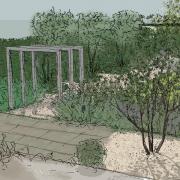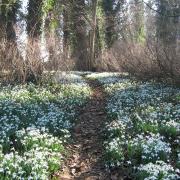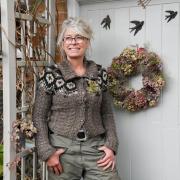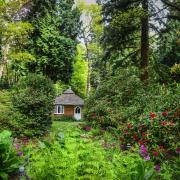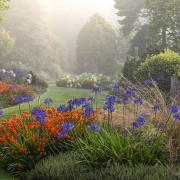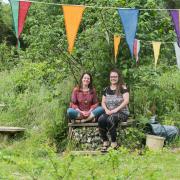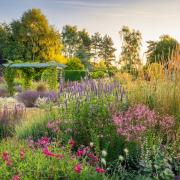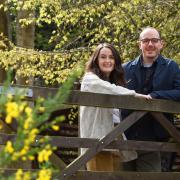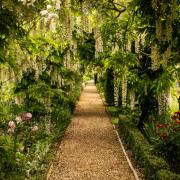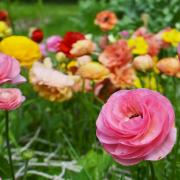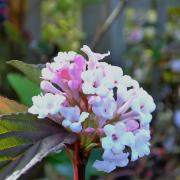Every week new wonders appear as gardener Sam Garland watches spring wash through the Bishop’s Garden

It is the season of budding and blossom with trees and shrubs spangled with shoots, leaves unfurling from twigs and stems pushing up through bare earth. In his first springtime as head gardener for the Bishop of Norwich the appropriately named Sam Garland is thrilled to find out exactly what is emerging in the city’s oldest private garden.
Not that he has much time for simply watching. The four acre patch of paradise in the Cathedral Close keeps him constantly busy planning, potting, planting, pruning, propagating, picking, digging, weeding and feeding.
The garden is as old as the 900-year-old cathedral itself – and part of the soaring building’s original intricately patterned Norman stonework is only visible from this ancient place. Every time Sam’s spade digs into the earth here he is following in the gardening traditions of generations of experts, beginning with monks growing food and medicines, and is almost as likely to turn up ancient masonry as modern worms.
Parts of the garden still follow the original layout and in dry periods the lawn reveals ghosts of long-gone Norman buildings. One of the architectural features which remains is a grand medieval porch which led into the 14th century bishop’s palace.

Today’s Bishop lives in a 1950s house, but parts of his garden are still surrounded by high walls built almost seven centuries ago. They shelter tranquil lawns, glorious herbaceous borders, many unusual plants from around the world, a bamboo walk, trees, tree ferns, a meadow grass labyrinth centred on a 400-year-old pear tree, a hebe grown from a sprig Queen Victoria carried in her wedding bouquet in 1840 and an all-pervading sense of peace.
Sam relishes the variety packed into this lush and lovely four acres, surrounded by city but alive with wonders of the natural world. Propagating is a particular passion. “There is something pretty magical about getting a seed or a cutting and making it grow,” said Sam. “Growing fruit and vegetables is endlessly amazing.” He has already planted a new orchard, scented garden, medicinal herb garden and cut flower garden.
All fit with the Bishop’s mission to promote ecological values and reduce environmental impact. Soon flowers for events and meetings will be picked just metres away and the kitchen garden should be overflowing with all the usual organic fruit, vegetable and salad crops plus exotic fare including ochra, tomatilloes and agretti – a saltwort which Sam describes as a bit like samphire.
Less than a century ago, 15 full time gardeners worked here. Today Sam works with a part time assistant, helped by a team of volunteers and, occasionally, the Bishop himself. Bishop Graham is a keen gardener with a particular interest in the environment and conservation.

He studied ecology before theology and his Norwich garden is now also home to a small collection of plants brought from his previous home, plus 350,000 bees. Sam has been stung – but says it was entirely his own fault as he was wielding a noisy hedge trimmer perilously close to their hives.
Sam first arrived in Norfolk to study philosophy at the University of East Anglia but has always loved horticulture. He grew up in the Peak District and began gardening as a child. He said his grandfather was ‘obsessed’ with azaleas and as a teenager Sam worked at a garden centre, and helped people out with their gardens. “I got pretty obsessed with gardening too!” he said.
After a degree and a masters degree in philosophy, and a stint teaching English in Spain, he returned to Norfolk for a horticultural course at Easton College and worked as a volunteer in the National Trust gardens at Felbrigg Hall. He managed the gardens at Swannington Manor, near Reepham, before continuing his gardening education and career at the Royal Horticultural Society’s flagship gardens in Wisley.
Now he is back in Norfolk and the gardener with the suitably floral name has even more flowers in his life, with a partner called Fuchsia. His parents have fallen for the county too. Together they have all bought a piece of land to set up an orchard, vineyard and vegetable allotment. And might the vineyard eventually supply communion wine to the diocese? “I like that idea!” said Sam.
Come into the garden
[NB: In light of the COVID-19 outbreak, certain of these events are cancelled, so please check the website.]
The Bishop’s garden will be open on:
• April 19 for Norfolk testicular cancer charity It’s on the Ball,
• May 3 for pregnancy loss charity TimeNorfolk
• May 17 for Norwich-based drug and alcohol rehab charity Hebron Trust
• May 24 for Norwich Puppet Theatre
• May 31 for head injuries charity Headway
• June 7 for YMCA Norfolk
• June 14 for the King’s Lynn Night Shelter
• June 28 for the National Garden Scheme charities
• July 5 for Norwich Foodbank
• July 12 for the Papillon Project which creates and develops school allotments
• July 26 for the Friends of Horsey Seals
• August 2 for the Norwich-based young people’s charity MAP (Mancroft Advice Project)
• Each open afternoon is from 1-4.30pm. Adults £5, accompanied children and wheelchair users free, assistance dogs only. Refreshments available. dioceseofnorwich.org/about/bishops/norwich/gardens
The Bishop will also be opening the garden as part of the international Quiet Gardens movement which invites people into gardens to soak up the atmosphere of peace and creativity while walking, praying, painting, writing or meditating. Other Quiet Gardens in Norfolk include the garden beside St Lawrence’s Church in South Walsham and at St Seraphim’s orthodox chapel in the old railway station at Little Walsingham.
Here the garden is laid out as a pilgrimage journey from a rose-covered pergola, past raised flower beds and a Celtic cross made of sedum, to a hilltop hut with views across the village. It is officially open every Wednesday and Saturday but visitors are welcome at any time. Quiet days are also held on the third Friday of each month.




